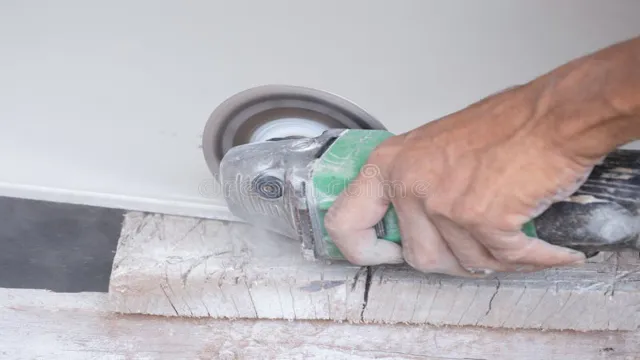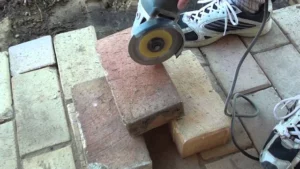If you’re looking to lay some large tiles, you might be overwhelmed by the task of cutting them down to size. But fear not, there’s an easy way to do it: using an angle grinder. Not only is it a quick and efficient method, but it can also save you money compared to hiring a professional.
An angle grinder is a versatile tool that can be used for many DIY tasks, but cutting tiles is one of its most popular applications. With the right blade and technique, cutting large tiles can be a breeze. Plus, you’ll end up with cleaner cuts than you would with a tile cutter or score-and-snap method.
In this blog post, we’ll go over everything you need to know about cutting large tiles with an angle grinder. We’ll cover the necessary tools and precautions you should take, as well as tips and tricks to make the process go smoothly. By the end, you’ll have the confidence to tackle any tile-cutting project on your own.
So roll up your sleeves and let’s get started!
Choose the Right Blade
When it comes to cutting large tiles with an angle grinder, choosing the right blade is crucial. Not all blades are created equal, and selecting the appropriate one will make all the difference in the success of your project. A diamond blade is considered the best option for cutting tiles, as it can slice through hard materials like porcelain and ceramic with ease.
It’s important to note, however, that not all diamond blades are designed for the same purpose. Make sure to select a blade specifically created for cutting tiles, as these will have a much higher concentration of diamonds in the blade segments. This will enhance the precision of your cuts and ensure a smooth finish.
With the right blade in hand, you’ll be able to tackle that large tile project with ease and confidence.
Consider the Tile Material
Choosing the right blade for your tile project is crucial to ensure a clean and precise cut. The type of blade you choose largely depends on the material of your tile. For example, if you are working with ceramic or porcelain tiles, a diamond blade with continuous rims is your best option.
However, if you are cutting through natural stone tiles such as marble or granite, a segmented blade with a softer bond is more suitable. The blade’s size also plays a vital role in the outcome of your project. If you choose a blade that is too small, it will take longer to make cuts.
On the other hand, if you choose a blade that is too large, it may cause your tile to crack due to the excessive pressure. By considering the tile material and choosing the right blade size and grit, you can achieve precise cuts and a flawless finish on your tile project.

Choose the Blade Size
When it comes to choosing the right blade for your project, the size of the blade is a crucial factor to consider. A blade that is too small won’t be able to handle the demands of larger projects, and a blade that is too large can be difficult to maneuver and control. The size of the blade needed will depend on what you’re using it for.
For example, if you’re cutting through thick pieces of wood, you’ll need a larger blade that can power through the material. However, if you’re working on a more intricate design, a smaller blade might be necessary for precision and accuracy. It’s important to take into account the material you’re working with and what kind of cut you’re trying to achieve.
By choosing the right blade size, you’ll be able to work more efficiently and produce the desired results. So next time you’re reaching for a blade, take a moment to consider the size and choose the one that will get the job done right.
Preparing the Tile
Cutting large tiles with an angle grinder can be a convenient and efficient way to complete a tiling project. However, before getting started, it is important to properly prepare the tile. The first step is to measure and mark the area that needs to be cut, ensuring that the line is straight and accurate.
Once the area has been marked, use a straight edge or ruler to guide the angle grinder and ensure that the cut remains even. It is also important to wear safety gear, such as gloves and goggles, to protect yourself from any debris or dust that may be kicked up during the cutting process. Finally, before starting the angle grinder, make sure that the blade is securely attached and that it is appropriate for cutting tiles.
By following these steps and taking the necessary precautions, you can successfully cut large tiles with an angle grinder and achieve professional-looking results.
Measure and Mark the Tile
Before installing the tile, it’s crucial to prepare it properly. One of the essential steps is to measure and mark the tile to ensure that it fits accurately in the space that you want. First, measure the area where you want to install the tile and calculate how many tiles you’ll need.
Next, mark the center of the area using a chalk line, so you know where to start placing the tiles. If the area is not square or rectangular, you’ll need to make some cuts to the tile to fit the space correctly. Make accurate measurements and mark the tiles using a pencil to avoid errors.
Use a tile cutter or a wet saw to make the cuts on the marked tiles. Remember to double-check all the measurements and cuts, so everything fits perfectly. By taking your time to prepare the tile accurately, you’ll save yourself headaches and achieve a beautiful finished look.
Secure the Tile
When it comes to securing your tile, the first step is preparing it properly. In order to ensure a safe and long-lasting installation, it’s important to start with a clean and level surface. This means removing any debris or old adhesive and making sure the subfloor is free of any bumps or dips.
Once the surface is prepped, it’s time to choose the right adhesive for your tile type and location. For example, if you’re installing tile in a wet area like a bathroom or kitchen, you’ll want to use a waterproof adhesive. In addition to choosing the right adhesive, it’s also important to measure and cut your tile carefully to ensure a precise fit.
By taking the time to properly prepare your tile, you can ensure a sturdy and secure installation that will stand the test of time.
Cutting the Tile
If you’re looking to cut large tiles with an angle grinder, there are a few things you need to know. Firstly, make sure you have the correct blade for your grinder, as not all blades are suitable for cutting through tile. Diamond blades are recommended for cutting through tough materials like ceramics and porcelain.
Secondly, measure and mark the tile where you want to cut it using a straight edge or chalk line. Make sure you’re wearing protective gear like goggles and a mask to avoid inhaling dust particles. Begin cutting the tile by holding your grinder at a slight angle and slowly moving it along the marked area.
Take your time and make sure you’re applying constant pressure to the blade. Once you’ve cut along the line, flip the tile over and repeat the process on the other side. Finally, use a tile file to smooth out any rough edges and you’re good to go!
Put on Protective Gear
When it comes to cutting tiles, you need to put on protective gear before you start. Tiles are made of materials like ceramic, porcelain, or stone, which are hard and brittle. This can make them dangerous to handle, especially when you’re cutting them.
The process involves using power tools like saws, grinders, or cutters that generate a lot of dust and debris. Without protection, you risk inhaling this dust, which can cause respiratory issues, allergic reactions, or infection. Additionally, tiles can produce sharp edges or fly off during cutting, posing a risk of injury to your eyes or skin.
To avoid these potential hazards, put on safety glasses, a dust mask, and gloves before you begin cutting the tile. Remember, it’s better to be safe than sorry!
Start Cutting Slowly
When it comes to cutting tile, it’s important to start slowly and carefully. Using a tile cutter or wet saw can allow you to make precise cuts, but it can also become dangerous if you rush the job. Before starting, make sure you have all the necessary safety equipment, such as goggles and gloves.
Take your time and measure the tile precisely before starting to cut. When using a tile cutter, apply steady pressure and use the scoring wheel to create a shallow line in the tile. Then, use the lever to snap the tile along the scored line.
If using a wet saw, make sure the water is flowing properly to keep the blade from overheating. Slowly push the tile towards the blade, making sure to keep your fingers away from the cutting area. With patience and attention to detail, you can make precise cuts and achieve a professional-looking finish.
Make Straight Cuts
When it comes to cutting tiles, getting the right cut is crucial for a successful project. One of the most important things to keep in mind is making straight cuts. This can be easier said than done, especially if you’re using a handheld tile cutter.
However, there are a few tips and tricks to help you achieve a straight cut. Firstly, it’s important to mark where you want to make the cut with a pencil or marker. Use a straight edge or ruler to make sure your line is as straight as possible.
Next, take your time when making the cut, ensuring you’re cutting along the marked line at a steady pace. It’s important not to rush this step, as it can lead to crooked cuts and uneven tiles. Finally, double-check your work once you’ve made the cut to ensure it’s as straight as possible.
By following these simple steps, you’ll be able to make straight cuts on your tiles with ease and achieve a professional finish on your tiling project.
Finishing the Cut
When it comes to cutting large tiles with an angle grinder, there are a few important steps to follow in order to ensure a clean, accurate cut. Firstly, make sure your angle grinder is fitted with a diamond-tipped cutting wheel designed for ceramic or porcelain tiles. Secondly, measure and mark your tile where you want to make the cut, and be sure to use a straight edge or ruler to ensure precision.
Next, turn on your angle grinder and slowly guide the cutting wheel through the tile, applying steady pressure to avoid cracking or chipping the tile. Remember to wear protective gear such as eye goggles and a dust mask, as cutting tiles can create a lot of dust and debris. With practice and attention to detail, cutting large tiles with an angle grinder can be a quick and efficient way to achieve professional-looking results.
So why not give it a try?
Remove any Jagged Edges
One crucial step in ensuring a clean and professional cut is to remove any jagged edges. These can often be left behind after using tools like saws or scissors, and can detract from the overall appearance of the finished product. One easy way to remove these edges is to use sandpaper or a metal file, which can smooth out rough spots and create a consistent and smooth surface.
It’s important to take your time when doing this, as rushing the process can lead to further damage to the material or tool you’re working with. By taking care to remove any jagged edges, you can ensure that your final product looks polished and professional.
Smooth Out the Edges
When it comes to woodworking, creating a clean and polished final product is all about the details. Finishing the cut is a crucial step in achieving a professional-looking creation. To get those smooth edges, it’s important to use the right tools and techniques.
Sandpaper is a must-have, starting with a coarser grit and working your way up to a finer grit for a polished finish. A block plane is also useful for trimming any rough spots or uneven edges. Taking your time and using a steady hand will help ensure a clean result.
Don’t rush the process; taking your time will make all the difference. So, the next time you’re working on a woodworking project, remember to prioritize finishing the cut and smoothing out the edges. Your finished product will thank you!
Conclusion
In conclusion, cutting large tiles with an angle grinder can seem like a daunting task, but with the right technique and safety precautions, it can be a breeze. Make sure to measure and mark your tile precisely, use a good quality diamond blade, and keep a steady hand while cutting. And remember, always wear protective gear to prevent any injuries – because no DIY project is worth sacrificing your safety for.
With these tips in hand, you’ll be able to tackle any tiling project without breaking a sweat (or a tile)!”
FAQs
What safety measures should be taken while cutting large tiles with an angle grinder?
It is important to wear protective gear, such as goggles, gloves, and a respirator mask, to avoid inhaling tile dust. You should also use clamps to hold the tile securely in place and avoid cutting near the edges of the tile.
What type of blade should be used for cutting large tiles with an angle grinder?
A diamond blade is recommended for cutting large tiles with an angle grinder. These blades are designed to cut through hard materials like porcelain and ceramic tile.
How can I make sure my cuts are straight and accurate when cutting large tiles with an angle grinder?
You can use a straight edge or a guide to help guide the angle grinder as you make your cuts. It’s also important to take your time and go slowly to ensure accuracy.
Can I use an angle grinder to cut curves in large tiles?
Yes, you can use an angle grinder to cut curves in large tiles, but it can be more difficult and time-consuming than cutting straight lines.
Is it necessary to use water when cutting large tiles with an angle grinder?
While it’s not always necessary, using water can help reduce dust and keep the blade cool, which can increase its lifespan and improve the quality of your cuts.
Are there any other tools that can be used to cut large tiles besides an angle grinder?
Yes, tile saws and tile cutters are other options for cutting large tiles. These tools may provide more precise and cleaner cuts than an angle grinder in some cases.
What steps should I take to maintain my angle grinder after cutting large tiles?
After cutting large tiles with an angle grinder, it’s important to clean the tool thoroughly and remove any debris or dust. You should also check the blade for damage or wear and sharpen or replace as needed.







